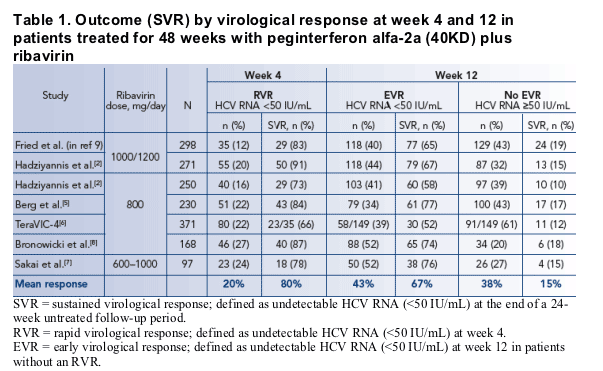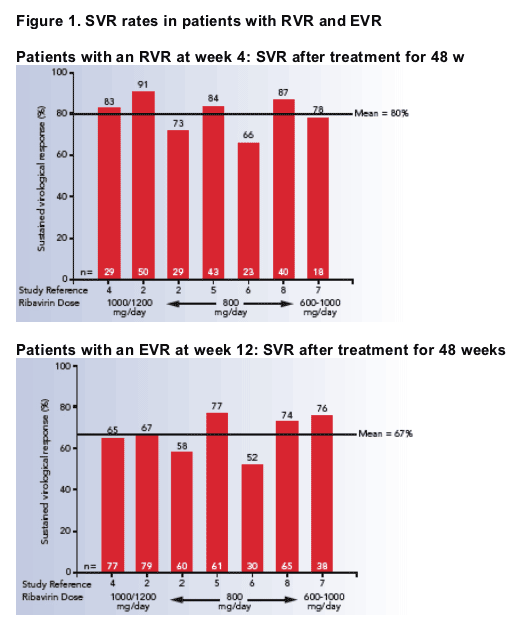 |
 |
 |
| |
Virological response at 4 and 12 weeks predict high rates of sustained virological response in genotype 1 patients treated with peginterferon alfa-2a (40KD) plus ribavirin
|
| |
| |
Reported by Jules Levin
EASL, April 2007, Barcelona, Spain
2 new studies reported at EASL found genotype 1 patients with no response until week 12 had better SVR rates with 72 weeks than with 48 weeks therapy. One study found patients HCV-negative by week 12 and the other study found patients with >2 log drop at week 12 achieved better SVR rates with 72 weeks. So, in other words patients with 2 log drop or HCV-negative at week 12 but not earlier can improve SVR rates with 72 weeks therapy compared to 48 weeks.
P. Marcellin,1 S.J. Hadziyannis,2 T. Berg,3 J.M. Sanchez-Tapias,4 J-P. Bronowicki,5 T. Sakai,6 A. Lin,7 A. Tietz,8 P. Ferenci9
1H˘pital Beaujon, Clichy, France; 2Henry Dunant Hospital, Athens, Greece; 3Universitat zu Berlin Med Klinik, Berlin, Germany; 4Hospital Clinic, Institut d'Investigacions Biomediques August Pi i Sunyer, Barcelona, Spain;
5CHU de Nancy, Vandoeuvre-les-Nancy, France; 6The Japanese Red Cross Musashino Junior College of Nursing, Tokyo, Japan; 7Roche, Nutley, NJ, USA; 8Roche, Basel, Switzerland; 9Medical University of Vienna, Vienna, Austria
INTRODUCTION
For the majority of patients with chronic hepatitis C and HCV genotype 1 infection, the recommended regimen of peginterferon alfa-2a (40KD) (PEGASYS) is 180 _g/week plus ribavirin (COPEGUS) 1000 or 1200 mg/day for 48 weeks.[1] This recommendation is based on the results of a phase III randomised multinational trial that examined the effect of treatment duration
and ribavirin dose on sustained virological response (SVR) rates.[2] Current guidelines recommend determining HCV RNA at week 12, because the
negative predictive value for SVR in patients who do not become HCV RNA negative or do not have a >2-log drop in HCV RNA levels at this time point is
97%.[1] Retrospective analysis of the study by Hadziyannis et al.[2] showed that 89% of genotype 1 patients with rapid virological response (RVR), defined
as undetectable HCV RNA in serum (<50 IU/mL) at week 4, achieved an SVR after just 24 weeks of treatment.[3] The positive predictive value of a complete response at week 12, i.e. undetectable HCV RNA (<50 IU/mL), has not been widely assessed. In order to evaluate the utility of the on-treatment virological response to identify patients with a high chance of a cure, we examined data from six randomised, multicentre trials in which the virological response was determined at week 4 and 12.[2, 4-8]
DISCUSSION
Genotype 1 patients with RVR, defined as undetectable HCV RNA at week 4 of treatment with peginterferon alfa-2a (40KD) (PEGASYS) plus ribavirin (COPEGUS), have a high probability of achieving an SVR (range 66-91%) with the currently recommended 48-week regimen.
Genotype 1 patients with EVR, defined as undetectable HCV RNA at week 12 of treatment, also have a high probability of an SVR (range 52-77%) with the standard regimen.
Use of higher ribavirin doses appears to result in higher SVR rates among patients with both RVR and EVR. However, other factors explaining
ribavirin dose effects, such as differences in baseline characteristics and randomisation, were not controlled for in this analysis.
Detectable HCV RNA at week 12 has a negative predictive value for SVR of 81-90%. Studies of treatment intensification strategies in these patients have shown
a benefit in those with a >2-log drop in HCV RNA.[5, 6]
CONCLUSION
Incorporation of on-treatment virological response at week 4 and 12 into the treatment algorithm for patients with genotype 1 could therefore:
--provide clinicians with a useful tool to identify patients with a high chance of cure
-- become part of a customised treatment approach
-- motivate and encourage patients.
METHODS
This analysis included data from genotype 1 patients enrolled in randomised, multicentre studies that evaluated 48 weeks of treatment with peginterferon alfa-2a (40KD) (PEGASYS) 180 _g/week plus ribavirin (COPEGUS). The daily dose of ribavirin varied across the six studies (see Table 1).[2, 4-8]
SVR was consistently defined as undetectable HCV RNA (<50 IU/mL by qualitative PCR assay) at the end of a 24-week untreated follow-up period.
For the purposes of this analysis, RVR was defined as undetectable HCV RNA (<50 IU/mL) at week 4, and early virological response (EVR) was defined as undetectable HCV RNA at week 12 in patients without an RVR.

RESULTS
Data from a total of 1685 genotype 1 patients were included in the analysis, of whom 330 achieved RVR (20%, range 12-27%; Table 1).
Among patients with an RVR, the mean SVR rate was 80% (range 66-91%; Table 1 and Figure 1).
Across the six studies the mean EVR rate was 43% (range 39-52%; Table 1).
Among patients with an EVR, the mean SVR rate was 67% (range 52-77%; Table 1 and Figure 1).
In contrast to the high SVR rate in patients with RVR and EVR, patients with detectable HCV RNA at week 12 had SVR rates of only 10-19%, regardless of whether a >2-log drop was achieved or not (Table 1).

REFERENCES
1. Strader DB, Wright T, Thomas DL, et al. Diagnosis, management, and
treatment of hepatitis C. Hepatology 2004; 39(4): 1147-71.
2. Hadziyannis SJ, Sette H, Jr., Morgan TR, et al. Peginterferon-alpha2a and
ribavirin combination therapy in chronic hepatitis C: a randomized study of
treatment duration and ribavirin dose. Ann Intern Med 2004; 140(5): 346-55.
3. Jensen DM, Morgan TR, Marcellin P, et al. Early identification of HCV
genotype 1 patients responding to 24 weeks peginterferon alpha-2a
(40 KD)/ribavirin therapy. Hepatology 2006; 43(5): 954-60.
4. Fried MW, Shiffman ML, Reddy KR, et al. Peginterferon alfa-2a plus ribavirin
for chronic hepatitis C virus infection. N Engl J Med 2002; 347(13): 975-82.
5. Berg T, von Wagner M, Nasser S, et al. Extended treatment duration for
hepatitis C virus type 1: comparing 48 versus 72 weeks of
peginterferon-alfa-2a plus ribavirin. Gastroenterology 2006; 130(4): 1086-97.
6. Sanchez-Tapias JM, Diago M, EscartÝn P, et al. Peginterferon-alfa2a plus
ribavirin for 48 versus 72 weeks in patients with detectable hepatitis C virus
RNA at week 4 of treatment. Gastroenterology 2006; 131(2): 451-60.
7. Sakai T, Iino S, Okuno T, et al. High response rates with peginterfeon alfa-2A
(40KD) (PEGASYS«) plus ribavirin (COPEGUS«) in treatmentnaive Japanese
chronic hepatitis C patients: a randomised, double-blind, multicentre, phase
III trial [abstract 605]. J Hepatol 2006; 44(Suppl 2): S224-5.
8. Bronowicki JP, Ouzan D, Asselah T, et al. Effect of ribavirin in genotype 1
patients with hepatitis C responding to pegylated interferon alfa-2a plus
ribavirin. Gastroenterology 2006; 131(4): 1040-8.
9. Ferenci P, Fried MW, Shiffman ML, et al. Predicting sustained virological
responses in chronic hepatitis C patients treated with peginterferon alfa-2a
(40 KD)/ribavirin. J Hepatol 2005; 43(3): 425-33.
|
| |
|
 |
 |
|
|